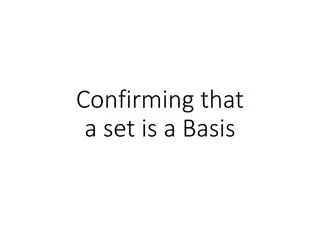Understanding Ergotherapy: Theoretical Basis, Concepts, and Application
Ergotherapy, based on specific activities, aims to enhance individuals' functioning in all aspects of life. This profession, led by ergotherapists, focuses on improving patients' quality of life, independence, and ability to engage in meaningful activities. Grounded in the principles of spirituality, uniqueness, and environmental influence, ergotherapy highlights the importance of cultural, social, physical, and institutional components in therapy. By grasping the essence of ergotherapy, one can appreciate its role in aiding individuals in living fulfilling lives aligned with their needs, desires, and societal expectations.
Download Presentation

Please find below an Image/Link to download the presentation.
The content on the website is provided AS IS for your information and personal use only. It may not be sold, licensed, or shared on other websites without obtaining consent from the author. Download presentation by click this link. If you encounter any issues during the download, it is possible that the publisher has removed the file from their server.
E N D
Presentation Transcript
Ergotherapy: theoretical basis and concepts in the profession Department of Pedagogy and Psychology of I. P. Pavlov University of St Petersburg Associate Professor M. N. Maltseva
Definition of ergotherapy "Ergotherapy is the treatment of physical or mental disorders by using specifically chosen activitiesthrough which a person can achieve the highest level of functioning in all aspects of life."
Purpose of ergotherapy Improvement of patients' ability to live a decent life in keeping with their needs and desires as well as with the requirements of society.
The ergotherapist A specialist who, despite the patient's motor, cognitive or other limitations, helps the patient to become as independent as possible and helps him or her to return to a familiar lifestyle.
Activities in ergotherapy Giving meaning to life An important part of human health and life Organising human behaviour Evolving and changing over time Depend on the environment and affect the environment Have a therapeutic effect
The personality in ergotherapy Spirituality is a key factor in a person's personality and determines that person's choice of activities People are naturally active Every person is unique Every person has the ability to make choices and achieve change Anyone can participate in any activity A person influences the environment and changes under the influence of the environment
The environment in ergotherapy The concept includes cultural, social, physical and institutional components. (Family, colleagues, neighbours, friends, social class, national identity, place of residence, transport, work, school etc) The choice, organization and satisfaction of an activity depends on the relationship between the individual and his/her environment.
The ergotherapist's activity is aimed at functional recovery providing adaptation to existing constraints
Main steps of the ergotherapist's work Evaluation Goal setting Intervention Evaluation of results of intervention
Ergotherapy is not occupational therapy One of the distinctive features of ergotherapy is that it is an interdisciplinary speciality. It combines and uses knowledge of medicine, special education, psychology, psychiatry, sociology, biomechanics, ergonomics and other fields. This set of knowledge is used by an occupational therapist to restore or develop a client's ability to function independently in everyday life as far as possible. Therefore, the term "occupational therapy", most often associated with enforced treatment or work training for medical professionals, is completely incorrect in relation to ergotherapy.
Ergotherapists Work with people of all ages who have physical, cognitive, emotional or mental disabilities and, as a result of these disabilities have disabilities in activity and/or social participation in areas such as self- care, productive activities and leisure. In their work they not only analyse how certain disruptions to clients' structure and function affect their activity and participation in life, but also take into account the influence of both personal factors and environmental factors (social, physical, economic) on clients' functioning.
the task of ergotherapy is to: prevent the arising of restrictions on human activity with certain disorders and functional limitations by using activities that make sense to the person and are aimed at allowing that person to function at the highest possible level functioning and giving him or her independence in everyday life and improving his or her quality of life. These tasks are relevant in the acute period of illness (e.g. stroke), in- patient care, rehabilitation at home or in a health centre, as well as for the education and habilitation of children and adolescents with congenital diseases.
The team principle in the ergotherapist's work The driving principle of organisation is one of the distinctive features of the system of providing assistance to people with disabilities in many Western countries. An ergotherapist participates in an interdisciplinary team, i.e. a group of specialists that includes doctors, nurses, physical therapists, ergotherapists, speech therapists, psychologists, teachers and other specialists. They all work together to help a particular client and his or her family. In each case, the team consists only of those specialists whose help the client really needs. For example, the team working with a person who has had a stroke will include a nurse, a neurologist, a physical therapist and an ergotherapist, and if the client has communication problems, a speech therapist. For a small child with cerebral palsy it will be only a teacher and a physical therapist.
The team principle in ergotherapy Teamwork is based on partnerships between specialists; all decisions are made jointly after discussions, but each team member is responsible for his or her professional work. In addition to rehabilitation, treatment or care specialists, the team includes the client and, quite often, their relatives or other people close to them. Cooperation with the client, their family members or people in their immediate environment is essential for providing successful assistance.
Basic approaches in ergotherapy Clients should be provided with highly qualified assistance that aims to improve the quality of their life. The most important resources for ergotherapy are the client or the parents if the client is a child. The client, together with an ergotherapist, sets long- term and short-term intervention goals. Their common task is to help clients discover and use their own potential and their desire to achieve their goal. The ergotherapist is a member of an interdisciplinary team. Only by working together with an interdisciplinary team and the client and/or their relatives can we achieve positive results. The client should be considered in the context of the environment in all its diversity, from physical to economic and climatic factors, taking into account their mutual influence and subject to their active and continuous interaction. The relationship between ergotherapist and client should be defined as an open partnership based on trust.
Effective management in rehabilitation Rule: the efficiency of shared work falls if responsibility for the business is divided among many employees. At the same time, it is greatly enhanced if everyone is responsible for strategy development and decision-making within the scope of their professional competence. The effectiveness of rehabilitation depends on the cooperation, awareness and responsibility of each team member.
ergotherapists are not doctors, although they have higher education and sufficient knowledge of anatomy, physiology, pathology and other disciplines necessary to work with people with disabilities; are not nurses, although they can be effective in caring for even the most serious patients and can overcome many daily problems such as feeding or difficulty moving from bed to wheelchair; are not trainers or educators, although they can teach the right movement or the right way of doing an activity, as well as developing a training regime or helping to do a variety of exercises correctly; are not specialists in adaptive physical education or sports for people with disabilities, although they do help people with disabilities to improve their condition and find their way to socialisation; are not social workers, although they do have a close relationship with the client and his or her family, seeking to effectively address everyday problems and helping the person being helped to achieve maximum independence.
Ergotherapy is a speciality based on the scientifically prove facts that purposeful, meaningful activity (work) helps to improve a person's functional capabilities (motor, emotional, cognitive and mental).
The purpose of ergotherapy is to: Identify existing disorders, and restore or develop the functionality that a person needs in everyday life (activity); Help a person with disabilities to become as independent as possible in everyday life by restoring (developing) lost functions, using special devices, and by adapting surroundings. Create optimal conditions for development and self-realization of a person with disabilities through their "employment" in various spheres of life and, ultimately, improve their quality of life.
"Occupation" In ergotherapy the term "occupation" refers not only to work or occupational therapy. In ergotherapy, the term "occupation" describes the various activities that occur in the life of each person and give it meaning. In ergotherapy, occupation is divided into activity in everyday life, activity in work, productive activity, activity in games, recreation and hobbies.
Activity in everyday life includes: Personal hygiene measures (hair care, washing, using the toilet, etc). Dressing and using all items of clothing. Eating. Complying with rules necessary for maintaining and preserving health (including taking medication and procedures). Socialization (the possibility of full communication in society). Functional communication and mobility. The ability to be mobile in society. Satisfying of sexual needs.
Activity in work and productive activity includes: Carrying out household chores (clothing care, cleaning, cooking and keeping the room clean and safe). Taking care of other people. Being able to learn something new. Research activities (choice of profession, job search, job performance, retirement planning, voluntary participation in something).
Activity in games, recreation and hobbies includes: The ability to choose games, recreation and hobbies. The ability to carry out necessary actions during rest and play.
The ergotherapist aims to improve clients' ability to live a full life according to their wishes and needs in the context of their physical, social and cultural environment. So, if for a child with motor disabilities and for his parents it is now very important for him to be mobile within his home, then it is necessary to teach him to move about in a wheelchair at home. When dealing with stroke patients, it is important to know if they will be sent home or placed a hospital or health resort in the future. Learn about the location of the premises and the particular features of the exit to the street, and build the intervention according to the surroundings rather than abstractly.
"Improve the client's ability to live a full life." In an inpatient clinic : to depend as little as possible on the assistance of staff, to use the toilet on their own, to express wishes, to wash, to take the desired position, to move, to monitor the passage of time, to contact relatives by phone etc. In the house : to take care of oneself and the room, to dress, cook, do hobbies and play, to meet sexual needs, to help others etc. At work : to do a job or study.
Activity or purposeful activity is one of the main aims of ergotherapy. an ergotherapist uses it for various purposes. First, a certain activity may in itself be the purpose of the intervention. For example, the goal may be to master a game or increase the repertoire of a child aged 4-6 years with spastic tetraparesis. Or training to use a smartphone or e-book for an elderly stroke patient with a restricted range of movement of the right hand. Or teaching an elderly stroke patient with limited communication and social connections to use the Internet.
The activity can be used as a method of intervention For example, a child with spastic hemiparesis can be offered play with toys that will stimulate development of bilateral skills, that is, encourage the use of both hands while playing. An adult patient with left hand paresis should be offered an everyday action in which the left hand must be used to support, press or hold an object. Warning! The task may be difficult, but it must be achievable. The ergotherapist must be convinced of that and control the use of the damaged limb or organ in the process.
Activity is also a method of assessing the capacity of a client. You can offer clients an activity that makes sense to them, and the client must know how it is done; for example, suggest making a sandwich or offer the child a familiar toy. By observing how the client carries out this type of activity, we will be able to judge the posture they choose, their ability to move in space, and their movement abilities such as coordination, strength and stamina. In addition, we will be able to draw conclusions about the relationship of the client's motor capabilities (object capture, lifting, speed and sequence of movements) to planning of actions (ability to start task, search for necessary objects, sequence and logic of actions while carrying out the task).
In ergotherapy, relationships with clients and their relatives are not built on the principle of "prescribing" treatment, where the doctor or other specialist knows what the client needs for a speedy recovery. The core of an ergotherapist's work is cooperation and equal relationship with the client, where the client and/or his/her relatives are people who together with the specialist determine how the intervention programme will be planned and implemented.
the aim of an ergotherapist's work Can be defined as: "Allowing the client maximum adaptation to familiar life and satisfaction with life, through activities that have meaning and interest for the client. This activity is also therapy."
To achieve this goal, an ergotherapist Must have knowledge of - Psychology of adults and children, psychology of family and relations between child and parent, psychology of disability - The effects of disease and trauma on the human body - The structure of the human body and how its parts and organs work, including the nervous, muscular and bony systems - The energy needs of healthy and sick people - Human biomechanics - Ergonomics - Methods and techniques of rehabilitation, habilitation and education (kinesiotherapy, therapeutic physical training, sensory integration, correctional education, speech therapy etc). - Social support methods and techniques - Health and social support legislation
To achieve this goal, an ergotherapist Must have the following skills: Selection of types of activity and participation. Conducting ergotherapeutic interventions for the health rehabilitation, training or professional rehabilitation of a disabled person. Work involving client motivation Interviewing clients, rating them on ergotherapeutic and other scales and tests, and rating the client's surroundings Biomechanical, kinesiological and sensory correction Selection of technical rehabilitation and adaptation tools























